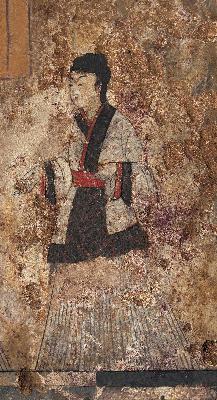- Koguryo and Balhae
- Susahn-ri Tomb
Koguryo and Balhae
| Title | Western Wall of the Main Chamber - Concubine 3 | ||
|---|---|---|---|
This is a detailed view of the third woman behind the noblewoman depicted on the western wall of the main chamber in Susahn-ri Tomb. Unlike the noblewoman and the first two concubines, this woman is not wearing any blush. However, she is wearing similarly luxurious clothing and raised hair. She is depicted to be the smallest of all nobility in the procession. This disparity provides important clues for establishing this woman's identity. This woman’s similar appearance to the two preceding concubines indicates that she is very unlikely to be a maid. However, she is noticeably smaller than the concubines and is not wearing any blush and is therefore certainly of lower status. This woman is estimated to be the wife of the noble couple's son, or in other words, their daughter-in-law. This speculation is not completely baseless in consideration of the “hierarchical representation of characters” or “hierarchical scale” used in ancient Koguryo portraiture. This woman's relatively short philtrum (vertical groove in the middle area of the upper lip) and small red lips are indicative of her much younger age when compared to the noblewoman and concubines. This image is an excellent example of the artist's meticulous attention to detail. This scene is a depiction of an outing by the nobleman, his three wives, son, and daughter-in-law.
The daughter-in-law is wearing a white Jeogori (traditional Korean upper garment) with elegant red embroidery, and the neckline and sleeves feature double Seons (accents on garments mimicking the black feathers on a crane’s neck or wingtips, influenced by Siberian shamanism) to enhance the luxurious appearance. Her Jeogori is in stark contrast to the single-layer, solid-color Seons featured on Jeogoris worn by servants and commoners of the era. The skirt is similar to those worn by the nobleman’s concubines. It’s a solid-color design, and the pleats are very narrow.
The front panels of Jeogoris (traditional Korean upper garment) were worn left to the right in a style known as U-im (Korean style for wearing traditional Hanbok; literally "panel right"). Although the opposite Jwa-im (literally "panel left") style was traditionally worn in Koguryo, both styles gained wide acceptance after U-im was introduced in the region by the Han Chinese. Sunshades, such as those covering the noble couple, are nowhere to be found.
Notably, the daughter-in-law’s hands are depicted not in a Gongsu pose (left hand placed above the right in a gesture of respect or submission) like the noblewoman and second wife, but rather seem to mimic Buddha's hands similar to the nobleman and his son. The balanced proportions, colorful embellishments, and flowing attire provide viewers with a glimpse of high-level Koguryo artistry. Just as with the noblewoman, this depiction can be considered as a valuable resource for understanding the extravagant and elegant outfits worn by Koguryo aristocracy.








